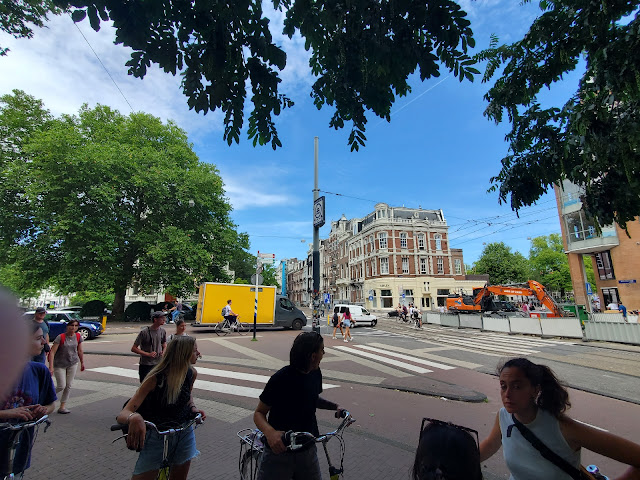Biking on Aero Island: Recreational Biking
Today, the group traveled to Aero Island. The task at hand: to complete an approximately 27 miles biking route around most of the island. The terrain varied from paved roads to gravel roads and included a brief stretch of dedicated bicycle lanes where the cars can travel at approximately 35 to 40 miles per hour. The trip felt like a recreational, cycling enthusiast ride, it allowed me to notice differences in biking infrastructure between a smaller community and what I observed while spending time in Copenhagen.
 |
| A bicycle highway lane running alongside a road on Aero Island |
 |
| View from the ferry of a small Danish town |
First and most notably is the shared space between bicyclists and automobiles. I saw narrow bike lanes painted on the roads closest to the harbor district area where our ferry dropped us off. However, on most of the island, dedicated bike lanes were absent, and cars shared the road with bicyclists. This included both paved roads and gravel roads in the more remote areas of the island. For the most part, cars and bikes shared the road well, and I felt little danger from being in the same space so long as I hung to the right. Yet, in some neighborhoods, I quickly learned to slow my approach when making a turn and to vigilantly peer ahead to watch for cars traveling against traffic. Part of this caution resulted from seeing an older woman driving faster than what I would consider acceptable in a neighborhood, and who needed to stop short suddenly when she recognized a pedestrian in her path. Building on that idea, the manner in which the hedges were cut in people’s yards created a few blind spots when I turned onto new streets. Close calls appear to be possible in the neighborhoods. Slowing down into each term seemed a prudent bicyclist strategy.
About halfway through the ride, we passed through a town on the route that painted its bike lanes red, a contrast to what James of Copenhagenize described in Copenhagen (i.e., painting the bike lane intersections blue). In his explanation, James mentioned the research demonstrated that blue paint, rather than red or green paint, best assisted both bicyclists and motorists in recognizing space for where bicyclists and motorists should be. In addition, he mentioned how the blue paint performed better in maintaining its quality compared to the red paint, mentioning how it faded into the road pavement and turned into a ‘terracotta’ like red that faded into the asphalt. However, this lane appeared newer as the red-painted visibly delineated the bike lane, despite the lane’s narrowness.
 |
| A sign designates national Bike Route 91 |
 |
| "Shark Teeth" indicate to yield to oncoming traffic |
Throughout the route, I found identifying elements of biking
as transport difficult. Most individuals appeared to use the same roads we
traveled as part of a recreational ride and I noticed most bike types as the
typical two-wheeled passenger bike. On the last mile of our route, I did spot
one cargo bike parked across the road. When we passed through a few towns, or
perhaps more apt to describe them as villages, on the island, narrow, painted
bike lanes appeared to allow us space for traveling back towards the harbor
area. One of the challenges of this ride is the fact that our group followed a
pre-determined route around the island that about half the time also coincided
with the official nationally designated bike route. I tried to use these blue
signs as wayfinding and only halfway through the trip realized, coming to a
stop to check our position, that we were not actually following the bike route.
Foolish me.
 |
| A small farm stand set up outside a resident's home offering jams |
Overall, Aero Island proved to be a challenging ride for me. If this route reflected a recreational biking opportunity, my takeaway is segments of the route certainly provided a challenge for those bicyclists that enjoy pushing their ability to traverse up and down the hills. For a more leisurely, recreational ride, following the official bike route through the segments closer to the villages and on the flatter, areas provide a picturesque experience through the island’s countryside. Even the towering windmills seemed right in place among the billowing grasses covering the island. Had a good fish samich for lunch too.
 |
| A series of wind turbines towering above the grasses of Aero Island's countryside |



Comments
Post a Comment